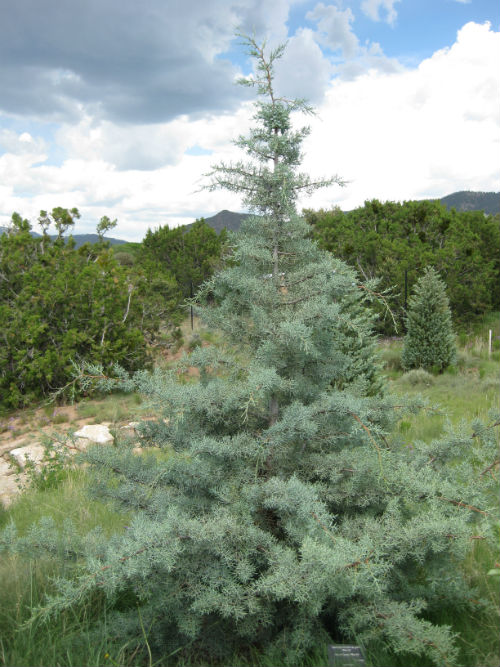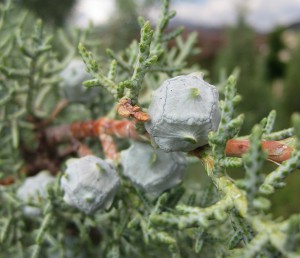Scientific name: Cupressus arizonica var. glabra ‘Blue Ice’
Common name: Arizona cypress ‘Blue Ice’

Cupressus arizonica var. glabra ‘Blue Ice’ (Photo: Cristina Salvador)
Family: Cupressaceae
Article by Susan Bruneni
In the winter landscape in Santa Fe, a highlight of the Botanical Garden at Museum Hill is the bluish-gray/silvery foliage of the Arizona cypress ‘Blue Ice’ with striking reddish bark. This festive cypress stands as a winter beacon pointing to more colorful times of the year. In fact, its colorful characteristics are so unique that it has been commercially cultivated for Christmas tree use.
Arizona cypress ‘Blue Ice’ is an evergreen, compact pyramidal tree, reaching 20 – 30 feet tall and 12 – 15 feet wide. It is drought tolerant once established, and grows about 18 – 24 inches per year. It is also heat tolerant, deer tolerant, and is basically insect-free in dry climates. Arizona cypress ‘Blue Ice’ is used for screen and privacy hedges and ornamentals. The United States Department of Agriculture recommends plantings for windbreaks. Foliage consists of evergreen scales flattened to form branchlets, the scales of which are tightly pressed against the stem. The scales retain their rich silver-blue/powdery-blue color all year. Cones are 3/4 – 1 inch in diameter, somewhat round, dark reddish brown, shield-shaped woody scales. The cones mature in autumn of the second season but persist on the tree for many years.

Arizona cypress ‘Blue Ice’ cones (photo: Cristina Salvador)
The species, Cupressus arizonica var. glabra, is native to central Arizona, but is also found in Southwestern New Mexico, Northern Mexico and West Texas, Utah and Southern California. It is one of five species of Arizona cypress, the only cypress native to the Southwest. It spreads in small, scattered populations rather than large forests.
Arizona cypress (species unconfirmed) are also featured in the elaborately and meticulously planned Clay Buchanan Memorial Garden, the 6.5-acre property surrounding the New Mexico State Capitol Building. Buchanan was the Roundhouse’s first Legislative Council Service director (drafting and legal research agency for the New Mexico Legislature. When the new Capitol building was completed in 1966, the 6.5 acre property was more or less a patch of weeds. Buchanan planned the garden specifically to showcase New Mexico plants from throughout the state. The Arizona cypress represents native growth in Southwestern New Mexico. Buchanan’s selections pared native plants with others imported into the natural landscape. He selected the many fruit trees on the grounds to represent Northern New Mexico’s abundant orchards. The Arizona cypress tower over the more than 100 varieties of plants and local artwork placed throughout the garden.
References:
Cupressus arizonica. (2015, December 3). In Wikipedia, The Free Encyclopedia. Retrieved 18:19, January 29, 2016, from https://en.wikipedia.org/w/index.php?title=Cupressus_arizonica&oldid=693639811
New Mexico State Capitol. (n.d.). Retrieved January 29, 2016, from http://santafe.org/New_Mexico_State_Capitol/
USDA NRCS Plant Materials Program (n.d.). Plant Fact Sheet: Arizona cypress. Retrieved January 29, 2016, from http://plants.usda.gov/factsheet/pdf/fs_cuar.pdf


